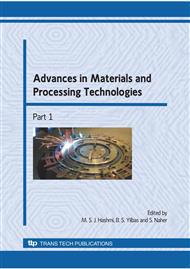p.1099
p.1107
p.1113
p.1121
p.1129
p.1135
p.1143
p.1151
p.1160
Proposal of a New Ultrasonic Welding Technique for Thermoplastic Polymer
Abstract:
This paper proposes an alternative ultrasonic welding technique capable of welding plastic parts with different shapes and sizes. In this method, a thin plastic sheet of less than 0.5 mm in thickness is fixed to the ultrasonic vibration body called the horn, and two plastic workpieces to be welded are pressed upon the sheet from both sides at a constant normal pressure. Once the horn starts to ultrasonically vibrate, frictional heat is momentarily generated between the sheet and the plastic workpieces, increasing the frictional temperature to a high level. When the temperature increases to over the melting point of all the materials, the materials melt and eventually are welded after the ultrasonic vibration stops. In the current work, an experimental apparatus was designed and constructed. A series of experiments was subsequently carried out on the apparatus to investigate how the surface roughness of the workpieces, the welding time, and the normal welding pressure affect the actual welding area and the tensile strength of the welded workpieces. The experimental results showed that a bigger welding area and a higher tensile strength can be obtained under the appropriate welding conditions, providing validation of the new welding method.
Info:
Periodical:
Pages:
1129-1134
Citation:
Online since:
December 2009
Authors:
Price:
Сopyright:
© 2010 Trans Tech Publications Ltd. All Rights Reserved
Share:
Citation:


